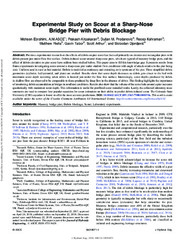| dc.creator | Ebrahimi, Mohsen | |
| dc.creator | Kripakaran, Prakash | |
| dc.creator | Prodanović, Dušan | |
| dc.creator | Kahraman, Recep | |
| dc.creator | Riella, Matthew | |
| dc.creator | Tabor, Gavin | |
| dc.creator | Arthur, Scott | |
| dc.creator | Đorđević, Slobodan | |
| dc.date.accessioned | 2019-04-19T14:30:41Z | |
| dc.date.available | 2019-04-19T14:30:41Z | |
| dc.date.issued | 2018 | |
| dc.identifier.issn | 0733-9429 | |
| dc.identifier.uri | https://grafar.grf.bg.ac.rs/handle/123456789/985 | |
| dc.description.abstract | Previous experimental research on the effects of debris on pier scour has focused primarily on circular and rectangular piers with debris present just under flow free surface. Debris-induced scour around sharp-nose piers, which are typical of masonry bridge piers, and the effect of debris elevation on pier scour have seldom been studied before. This paper aims to fill this knowledge gap. It presents results from flume experiments investigating scour around a sharp-nose pier under shallow flow conditions with angle of attack relative to the pier being zero. Uniform sand is used as bed material. Debris is modeled as stationary and extending only upstream of the pier. Three simplified debris geometries (cylinder, half-pyramid, and plate) are studied. Results show that scour depth decreases as debris gets closer to the bed with maximum scour depth occurring when debris is located just under the flow free surface. Interestingly, scour depths produced by debris in shallow flow are observed to be comparable to those produced by deep flow in the absence of debris. This finding highlights the importance of monitoring debris accumulation at bridges in nonflood conditions. Results also show that the volume of the scour hole around a pier increases quadratically with maximum scour depth. This information is useful for postflood scour remedial works. Lastly, the collected laboratory measurements are used to compare four popular equations for scour estimation on their ability to predict debris-induced scour. The Colorado State University (CSU) equation is found to offer the most accurate predictions. | en |
| dc.publisher | American Society of Civil Engineers (ASCE) | |
| dc.relation | United Kingdom's Engineering and Physical Sciences Research Council (EPSRC) EP/M017354/1 | |
| dc.rights | openAccess | |
| dc.source | Journal of Hydraulic Engineering | |
| dc.subject | Masonry bridge pier | en |
| dc.subject | Debris blockage | en |
| dc.subject | Scour | en |
| dc.subject | Laboratory experiments | en |
| dc.title | Experimental Study on Scour at a Sharp-Nose Bridge Pier with Debris Blockage | en |
| dc.type | article | |
| dc.rights.license | ARR | |
| dc.citation.issue | 12 | |
| dc.citation.other | 144(12): - | |
| dc.citation.rank | M22 | |
| dc.citation.volume | 144 | |
| dc.identifier.doi | 10.1061/(ASCE)HY.1943-7900.0001516 | |
| dc.identifier.fulltext | https://grafar.grf.bg.ac.rs//bitstream/id/4332/983.pdf | |
| dc.identifier.scopus | 2-s2.0-85053920363 | |
| dc.identifier.wos | 000447254300003 | |
| dc.type.version | publishedVersion | |

